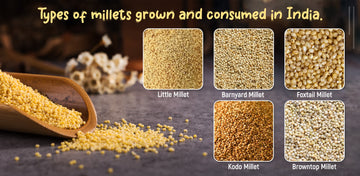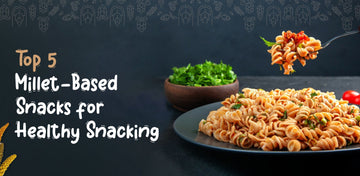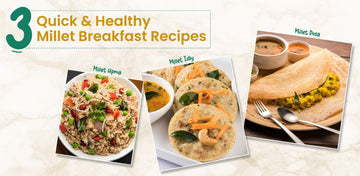
As the Indian urban thali evolves, the last few years have seen more millets adopted on it than previously. Although millets were traditionally a part of the rural diet, due to the increased health consciousness, they are now incorporated into meals in cities as well.
Okay, to begin with, let us first know what millets are.
What are millets?
Millets are ancient cereal grains. They are a sustainable and nutritious food source enriched with proteins, fiber, micronutrients, and health-enhancing phytochemicals. Their cultivation can be traced back to 8300 BCE, first grown in China and Africa, then later in Asia and Europe.
Outside the health angle that millets have, they are of low maintenance and good for the environment while serving their purpose as a sustainable food source. Millets are easy to farm as they require significantly less water compared to rice or wheat, have low carbon emissions, and can grow in a variety of environments.

Types of Millets in India
Barnyard Millet - सामवा (Samwa)
Cultivated in ancient Indian millet growing societies, this round, small millet with cream and white colour is called barnyard millet. The crop is extensively grown in Karnataka, Maharastra, Tamilnadu, Andhra Pradesh, Madhya Pradesh, Gujarat and Uttarakhand states of India.
In Ayurveda, Barnyard millet is known as ‘Shyamak’ and it has a number of uses in fasting in India. It is gluten-free and is rich in nutrients. The millet contains calcium, iron, magnesium, phosphorus, plus dietary fiber for effective digestion, and carbohydrates to provide energy. More specifically, B-complex vitamins, responsible for metabolism and other para-vital processes, are found in high quantities.
During the period of fasting in India, it is common for people to eat barnyard millet. It is easy to digest and has a low GI (glycemic index). Some people have bloat or gas after eating it, so they are advised to first soak it before cooking. After soaking, it can be boiled and prepared for use in salad, pulao, upma and others. Other uses of the material include use in idli and dosa in fermented form, porridge (kheer) and others.
Little Millet - कुटकी (Kutki)
Shavan is commonly referred to as little millet, and it can be observed that it has a light brown colour. This millet is grown in several parts of the country most notably in Orissa, Madhya Pradesh, Andhra Pradesh, Tamil Nadu, Chhattisgarh, Karnataka, Gujarat and Maharashtra states.
Little millet is an excellent source of antioxidants assisting in boosting immunity and its high protein factor sustains tissue regeneration. For strong bones, it contains calcium and iron as well as vitamins B and E which are essential for brain health. It is ideal for people with gluten intolerance as it does not contain gluten.
It is easy to prepare little millet—first, soak it for 15 minutes then simmer it on low heat. Pulao, salads, soups, and stews - are some of the traditional foods that can be made with it. Its application can go beyond ordinary recipes to include noodles, cakes, cookies, and many more food items.
Foxtail Millet - कंगनी (Kangni)
Foxtail millet is known to most as the golden grain of the millets. The minute seed has color variation from yellow to brown. These tiny golden seeds have been in existence for over 8000 years. This crop is mainly cultivated in the southern states of India including Andhra Pradesh, Karnataka, Telangana, and Tamil Nadu and also in Madhya Pradesh, Rajasthan, Maharashtra, and Uttar Pradesh.
A good source of vitamin B12, little millets help the heart, brain, and skin. It is ideal for diabetic patients as it has a low glycemic index and is also helpful in controlling cholesterol. It also works well as a food option to provide adequate amounts of iron.
Foxtail millet is great because it is used the same way as rice and can help make pulao, biryani, salad, or even upma. Moreover, they can be made into cookies, pasta, noodles, and pancakes for children.
Try our foxtail millet cookies
Kodo Millet - कोद्र (Kodra)
Kodo millet, also known as Varagu, is a grain that has been a staple in the northern regions of India for over 3000 years. According to Ayurveda, it is very light to digest and balances the vata, pitta, and dosha. It is now grown in Madhya Pradesh, Karnataka, Maharashtra, Chhattisgarh, Bihar, West Bengal, and Uttar Pradesh in India.
Rich in protein and fiber with almost no fat content, Kodo millet is highly digestible and suitable for diabetic patients. It possesses a good amount of lecithin, maintaining the nervous system strong. It is rich in many minerals like niacin, B6, folic acid, calcium, iron, potassium, magnesium, and zinc.
A healthy alternative to rice, Kodo millet can be made into upma, kheer, pulao and salad. One can even make breakfast with fermented foods like idli and dosa made from Kodo millet.
Changing the way millets are eaten with Milletry
Millets are more than just a dietary choice—they represent a shift toward healthier eating habits and environmentally conscious living. As we rediscover their potential, millets are becoming a key ingredient in urban meals.
We, at Milletry, are making millets tasty for you. From noodles and pasta to cookies, we’ve got everything you want made of millets. Millets can be healthy and tasty too.
Check out our variety of millet foods here.


